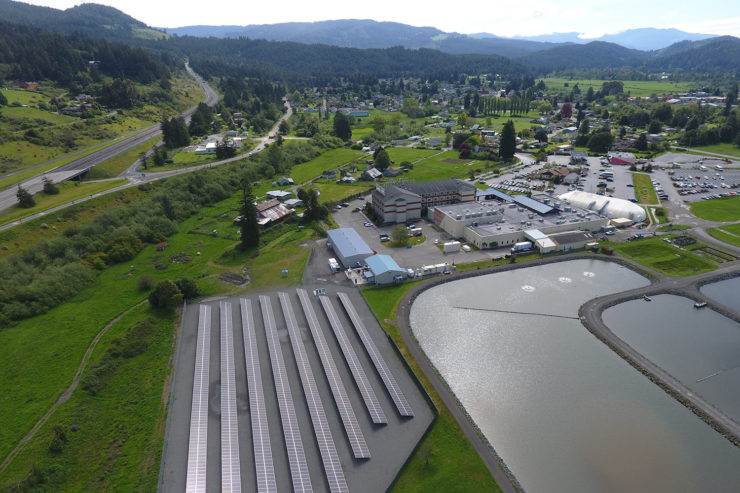Source: https://schatzcenter.org/blrmicrogrid/
The Blue Lake Rancheria (BLR) is located in California’s Humboldt Bay area, nearly 300 miles north of San Francisco. This rural region sits at the junction of three tectonic plates, and is subject to heavy rainstorms, forest fires, and frequent power outages. Located on the eastern edge of the Humboldt Bay community, the Rancheria houses tribal government offices, EV charging, a convenience store and gas station, a hotel and casino, and energy and water systems — including a low-carbon microgrid. Together, these facilities serve as an American Red Cross emergency evacuation site, and the Tribe was recognized by the Federal Emergency Management Agency in 2017 for their whole community preparedness efforts.

The BLR microgrid integrates a solar array, battery storage, and control systems to allow the Rancheria campus to operate in tandem with or islanded from the main utility grid. It generates renewable energy and provides approximately $150,000 in annual electricity savings. The BLR microgrid was funded by a $5 million grant from the California Energy Commission through their EPIC program. The Schatz Center was the prime contractor and lead technology integrator for the project.

In 2018, the microgrid was awarded the DistribuTECH Project of the Year for Distributed Energy Resource Integration.
In 2019, the capacity of the battery was more than doubled — from 500 kW/950 kWh to 1150kW/1950kWh — for increased grid support, load capacity, and resiliency duration. This expansion was significantly funded by the California Public Utilities Commission’s Self-Generation Incentive Program (SGIP).
Major project elements
- 420 kW photovoltaic array
- 1150 kW / 1950 kWh battery energy storage system
- microgrid management system
- PCC protective relay
- legacy 1 MW backup diesel generator
Islanding: The electrical service to the main BLR campus was reconfigured to create one point of common coupling (PCC) between the campus and the main utility grid. This PCC includes the powerline protections and control functionality required for the microgrid to automatically disconnect from the main grid during an outage, and then reconnect when grid power has been restored. Operators at BLR can also manually island the microgrid for energy management, maintenance, or security reasons. Seamless transitions between connected and islanded states are unnoticeable to building occupants, and have been approved by Pacific Gas & Electric, the local utility.
Optimal battery dispatch: Under normal conditions, the microgrid uses an energy load forecast, the solar availability forecast, and the current electricity rate schedule to determine when to store energy in the battery and when to dispatch it to the main grid.
Resiliency: If the main grid loses power, the microgrid automatically disconnects and begins operating in island mode. When islanded, the microgrid management system (MGMS) prioritizes clean generation — but if needed, the MGMS can also seamlessly bring a 1 MW isochronous backup generator online to support the PV and battery.
Load management: BLR staff have determined five priority levels for campus energy loads, which their operators can choose to “shed” (turn off) in the event of an extended power outage. Non-essential load shedding would allow the microgrid to operate indefinitely during an emergency.
Publications
- Final project report (Jan 2019)
Partners
Our partners and subcontractors on the original BLR microgrid project included: The California Energy Commission (major funder), the Blue Lake Rancheria (site host and major funder), Pacific Gas & Electric (local utility), Siemens (MGMS), Tesla (battery energy storage system), Idaho National Laboratory (testing and simulation), Robert Colburn Electric (electrical contractor), REC Solar (turnkey PV system), McKeever Energy & Electric (PV installation), GHD, inc. (electrical engineering), and Kernen Construction (civil construction for the project).
